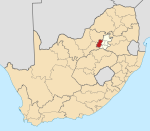
Soweto is a township of the City of Johannesburg Metropolitan Municipality in Gauteng, South Africa, bordering the city's mining belt in the south. Its name is an English syllabic abbreviation for South Western Townships. Formerly a separate municipality, it is now incorporated in the City of Johannesburg Metropolitan Municipality, and one of the suburbs of Johannesburg.
Sharpeville is a township situated between two large industrial cities, Vanderbijlpark and Vereeniging, in southern Gauteng, South Africa. Sharpeville is one of the oldest of six townships in the Vaal Triangle. It was named after John Lillie Sharpe who came to South Africa from Glasgow, Scotland, as secretary of Stewarts & Lloyds. Sharpe was elected to the Vereeniging City Council in 1932 and held the position of mayor from 1934 to 1937.
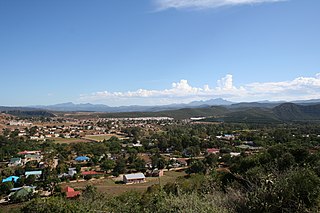
In South Africa, the terms township and location usually refer to the often underdeveloped racially segregated urban areas that, from the late 19th century until the end of apartheid, were reserved for non-whites, namely Black Africans, Coloureds and Indians. Townships were usually built on the periphery of towns and cities. The term township also has a distinct legal meaning in South Africa's system of land title, which carries no racial connotations.

Marabastad is a business area near the city centre of Pretoria, South Africa. The original Maraba Village, situated just to the south of the present Marabastad, was founded and ruled by the Ndebele Chief Maraba. The name Marabastad is the Afrikaans word meaning Maraba's Town.
Klerksdorp is located in the North West Province, South Africa. Klerksdorp, the largest city in the North West Province, is located 165 km (103 mi) southeast of Mahikeng, the provincial capital. Klerksdorp was also the first capital of the then Transvaal Republic and used to be the home of the first Stock Exchange in the region. It became an important trading town linking Kimberley to Johannesburg. It became home to a mix of farmers, miners and immigrants servicing the two industries.

Christiaan Frederick Beyers Naudé was a South African Afrikaner Calvinist Dominee, theologian and the leading Afrikaner anti-apartheid activist. He was known simply as Beyers Naudé, or more colloquially, Oom Bey.

Ernest Urban Trevor Huddleston was an English Anglican bishop. He was the Bishop of Stepney in London before becoming the second Archbishop of the Church of the Province of the Indian Ocean. He was best known for his anti-apartheid activism and his book Naught for Your Comfort.
Dobsonville is an suburb in Soweto.
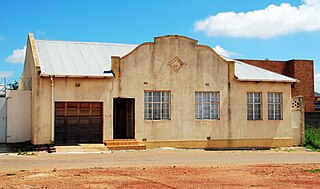
Pageview is a suburb of Johannesburg, South Africa. It is located in Region F of the City of Johannesburg Metropolitan Municipality. Populated by non-whites, predominantly Indians, until the 1970s, it was one of two adjacent suburbs commonly known as Fietas.

Rainbow Nation is a term coined by Archbishop Desmond Tutu to describe post-apartheid South Africa after South Africa's first fully democratic election in 1994.
Lwandle/Nomzamo is a small township in the Helderberg basin just outside Strand in the Western Cape of South Africa. Both names are sometimes used interchangeably referring to both places. This may be attributed to the fact that Nomzamo was born as a result of overpopulation in Lwandle area which initially designed as a cheap accommodation for "single male workers" during the apartheid years.

Desmond Mpilo Tutu was a South African Anglican bishop and theologian, known for his work as an anti-apartheid and human rights activist. He was Bishop of Johannesburg from 1985 to 1986 and then Archbishop of Cape Town from 1986 to 1996, in both cases being the first black African to hold the position. Theologically, he sought to fuse ideas from black theology with African theology.

Manenberg is a township of Cape Town, South Africa, that was created by the apartheid government for low-income Coloured families in the Cape Flats in 1966 as a result of the forced removal campaign by the National Party. It has an estimated population of 52,000 residents. The area consists of rows of semi-detached houses and project-like flats, known as "korre". The township is located about 20 km away from the city centre of Cape Town. It is separated from neighbouring Nyanga and Gugulethu townships by a railway line to the east and from Hanover Park by the Sand Industria industrial park to the west and Heideveld to the north. The northern part of Manenberg has wealthy people that are mostly Muslims. The rest of Manenberg has poor people that are mostly associated with Christianity.
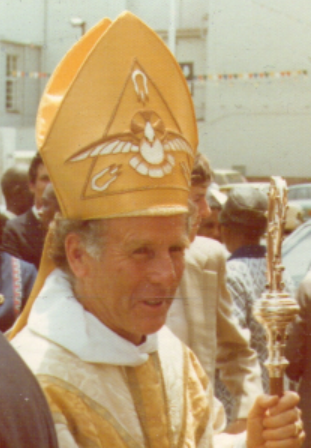
Philip Welsford Richmond Russell, was a South African Anglican bishop.
Alexander Lionel Boraine was a South African politician, minister, and anti-apartheid activist.

The Tutu House is a house on Vilakazi Street in Soweto, Johannesburg, South Africa, that was the home to Desmond and Leah Tutu. The house is registered as part of Johannesburg's historical heritage.
Thembalethu is a township in Western Cape, South Africa. The township is on the Garden Route and falls part of the George Municipality. The name of the township "Thembalethu" is Xhosa meaning "Our Hope".

Children of the Light is a documentary film produced by The PeaceJam Foundation about the life of Archbishop Desmond Tutu. It is the first film to tell the life story of Nobel Prize winner Desmond Tutu, one of the fathers of modern-day South Africa, and features extensive archival footage, family photos and never-before-seen interviews. It premiered at the Monte-Carlo Television Festival on June 8, 2014.
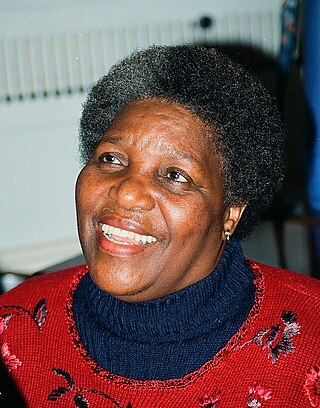
Nomalizo Leah Tutu is a South African activist and the widow of Desmond Tutu.
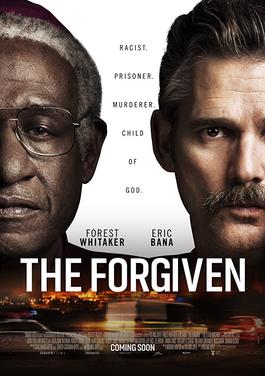
The Forgiven is a 2017 South African drama film directed by Roland Joffé starring Forest Whitaker, Eric Bana and Jeff Gum. Joffé co-wrote the script with Michael Ashton on the basis of the play The Archbishop and the Antichrist by Michael Ashton, which tells a story involving Archbishop Desmond Tutu's search for answers during the Truth and Reconciliation Commission and his meetings with the fictional character Piet Blomfeld.
















